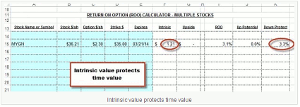Meaningful option calculations are essential in determining if the premiums meet our goals, says option expert Alan Ellman of TheBlueCollarInvestor.com.
To this end, we must understand the mathematics of these calculations to become elite covered call writers. Now don’t worry…we don’t have to become Albert Einstein to be successful. But we do have to have a general understanding of the components of the option premium and how they influence our investment decisions.
Let’s start with the basic equation:
Option premium = intrinsic value + time value
Intrinsic value applies only to in-the-money strikes and is the amount the strike price is below the current market value. As an example, if we bought Company BCI for $32 and sold the $30 call for $3, of that $3, $2 is intrinsic value (NOT profit) and $1 is time value (our true initial profit). Now, at-the-money and out-of-the-money strikes have premiums associated with them that are all time value since the strike price is not in-the-money.
Examples:
- At-the-Money: Buy BCI for $30 and Sell the $30 Call
- Out-of-the-Money: Buy BCI for $28 and Sell the $30 Call
In this article, I will discuss and show hypothetical and real life examples of how intrinsic value protects time value when selling in-the-money strikes.
Hypothetical Example
- Buy BCI @ $32
- Sell $30 Call @ $3
- Intrinsic Value = $2
- Time Value = $1
- Initial Profit = $1/$32 – $2 = 3.3%
Since we only count $1 of the $3 premium as initial profit and we did, in fact, receive a total of $3, what happened to the other $2? We use it to “buy down” our cost basis from $32 to $30. This means we are guaranteed our 3.3%, one-month return as long as share depreciation does not drop from $32 to below $30. I call this downside protection, which is quite different from breakeven. It is protection of the initial profit. It is calculated as follows:
Downside protection = $2/$32 = 6.3%
I view the downside protection as an insurance policy, which is paid for by the option buyer. When evaluating this trade, the calculations tell us the following:
We are guaranteed a 3.3%, one-month return as long as share value does not decline by more than 6.3% by expiration. If that trade meets your goals then it’s time to make some money.
As an aside, to calculate breakeven we deduct the entire option premium from the initial cost:
$32 – $3 = $29
Real-life Example: Myriad Genetics (MYGN)
At the time I am writing this article, the options chain for Myriad Genetics shows the following stats with three weeks remaining until expiration:
- Price = $36.21
- $35 Strike = $2.30
- Therefore, Time Value = $1.09 and Intrinsic Value = $1.21
Let’s allow the “multiple tab” of the Ellman Calculator to do the work for us:
The calculator shows that we are guaranteed a 3.1%, three-week returns as long as share value does not decline by more than 3.3% by expiration. One of the many perks of being a covered call writer is that this “insurance policy” is paid for by the option buyer, not by us.
Summary
When using in-the-money strikes, the intrinsic value protects the time value or our initial profit. These strikes are most appropriate in bearish or volatile markets, when chart technicals are mixed and when the investor’s risk-tolerance is extremely conservative.
By Alan Ellman of TheBlueCollarInvestor.com











